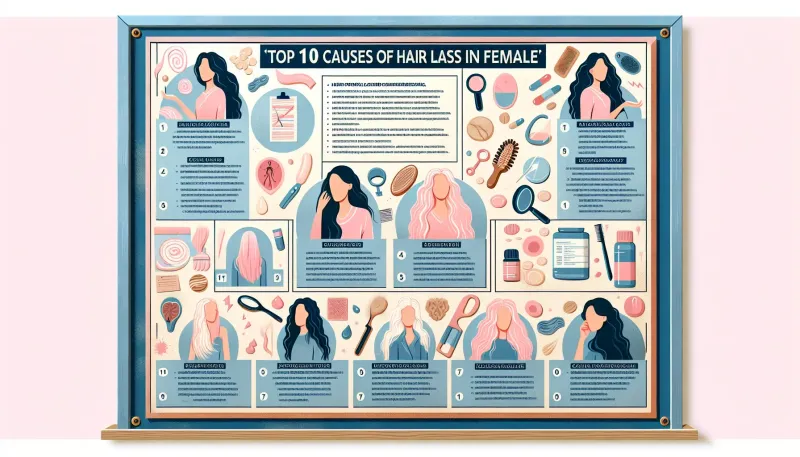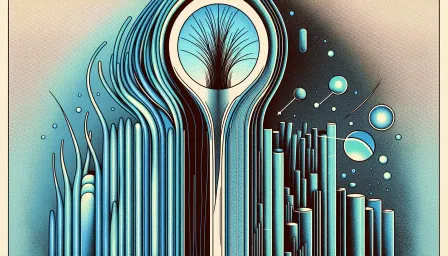Top 10 Causes of Hair Loss in Females: What You Need to Know

Explore the top 10 causes of hair loss in females. Understand the factors contributing to female hair loss and potential solutions to address these issues.
Hair loss can be a distressing experience for anyone, but it is especially challenging for females who often consider their hair to be a key part of their identity. Understanding the causes of hair loss in females is essential for finding effective treatment and overcoming this issue. This article reviews the top ten causes to help you understand the factors that might be contributing to your hair loss and what you can do about it.
1. Hormonal Imbalances
Hormonal changes are a primary cause of hair loss in women. Hormones like estrogen and progesterone play a crucial role in hair growth. Conditions like polycystic ovary syndrome (PCOS) and menopause alter hormone levels, leading to hair thinning and loss.
2. Genetics
While it's commonly believed that only men suffer from hereditary hair loss, females can also inherit genes from both of their parents that predispose them to hair thinning or loss. Female-pattern baldness, also known as androgenetic alopecia, typically results in thinning hair along the top of the head.
3. Stress
High stress levels can trigger hair shedding and thinning. Stress-related hair loss, also known as telogen effluvium, occurs when stress pushes large numbers of hair follicles into a resting phase, causing hair to fall out a few months later.
4. Nutritional Deficiencies
A balanced diet is vital for healthy hair growth. Deficiencies in key nutrients like iron, biotin, zinc, and protein can lead to hair loss. Iron deficiency anemia is a common cause of hair thinning in women.
5. Medical Conditions
Certain medical conditions like thyroid disorders (hypothyroidism and hyperthyroidism), autoimmune diseases (alopecia areata), and skin conditions (psoriasis and seborrheic dermatitis) can cause hair loss.
6. Hairstyles and Treatments
Regularly styling hair in tight ponytails, braids, or using chemical hair treatments can result in hair damage and loss. Traction alopecia occurs when these styles create constant tension on the hair, leading to hair breakage and thinning.
7. Medications and Treatments
Certain medications can have hair loss as a side effect. These include chemotherapy drugs, blood thinners, antidepressants, and medications for high blood pressure and arthritis. Always consult your doctor if you notice hair loss after starting a new medication.
8. Age
As women age, hair naturally begins to thin. This process usually starts in the 40s or 50s. The rate of hair growth slows, and hair strands become finer.
9. Pregnancy and Postpartum
During pregnancy, elevated hormone levels keep hair in a growth phase, resulting in lush hair. However, after giving birth, hormonal shifts can cause hair to enter the shedding phase, leading to noticeable postpartum hair loss.
10. Poor Hair Care Practices
Improper hair care, such as excessive use of heat styling tools, harsh shampoos, and lack of scalp care can weaken hair and cause it to fall out. Gentle hair care practices and proper scalp maintenance are essential for healthy hair.
Solutions and Treatments
Consult a Healthcare Provider
If you are experiencing significant hair loss, consult a healthcare provider or dermatologist. They can perform tests to determine the underlying cause and recommend appropriate treatments.
Balanced Diet
Ensure a nutrient-rich diet that includes plenty of vitamins and minerals. Consider supplements if you are unable to get these nutrients from food alone. Foods like leafy greens, nuts, seeds, and fish are excellent for hair health.
Stress Management
Managing stress through techniques like exercise, meditation, and adequate sleep can help reduce hair loss. Sometimes, counseling or therapy is beneficial for managing chronic stress.
Avoid Harsh Hair Treatments
Limit the use of chemical treatments and heat styling tools. Opt for gentle hairstyles that do not pull on the hair. Use high-quality, sulfate-free shampoos and conditioners to keep your hair and scalp healthy.
Medical Treatments
Depending on the cause, various medical treatments can help address hair loss. These may include topical treatments like minoxidil, prescription medications like finasteride, or procedures like platelet-rich plasma (PRP) therapy and hair transplants.
Conclusion
Understanding the causes of hair loss in females is the first step in addressing this common issue. From hormonal imbalances to nutritional deficiencies and beyond, multiple factors could be contributing to your hair loss. By identifying the cause and taking appropriate actions, you can effectively manage hair loss and work towards regenerating healthy hair. Always consult a healthcare professional for personalized advice and treatment options.



























